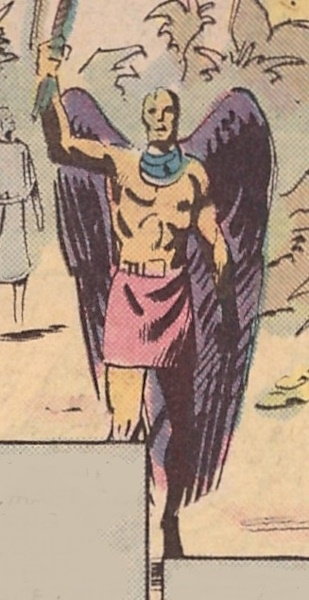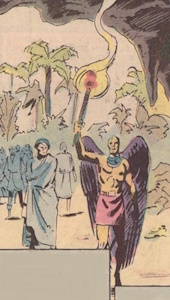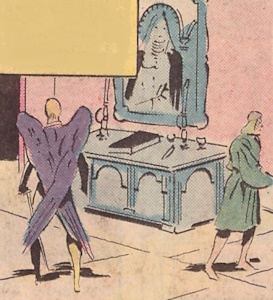
VER-JEEL
Real Name: Ver-Jeel
Identity/Class: Genetically-engineered winged human subspecies (Aerians) (13th century/possibly 14th century)
Occupation: Unrevealed (possibly a hunter)
Group Membership: Aerian race
Affiliations: Captain Dante Alighieri and his crew
Enemies: Belasco
Known Relatives: None
Aliases: "Virgil" (in Dante's poem)
Base of Operations: Pangea, Antarctica;
probably Aerie Shalan (or possibly Aerie Athmeth) (see comments)
First Appearance: Ka-Zar the Savage#11 (February, 1982)
Powers/Abilities: Like other Aerians, Ver-Jeel was a humanoid being who possessed large feathered wings that enabled him to fly, and may have had other avian characteristics in the form of adaptations that assisted him in flight. Those hypothetical adaptations may have included porous, bird-like bones (to reduce their weight) and/or eyes adapted to resist high-speed winds.
Like other Aerians, Ver-Jeel may have had feathers instead of hair or he may have had hair in addition to feathers. Or maybe he (and the other Aerians) had hair-like feathers?
While Ver-Jeel's body was orange-skinned, his feathered wings were purple. This coloration may have been unusual since modern-day Aerians were usually (but not always) essentially monocolored, with the feathers on their wings being the same color as the skin on their bodies (although their wings were sometimes a darker shade of their body's skin color).
Height: Unrevealed
Weight: Unrevealed
Eye color: Unrevealed
Skin color: Orange
Feather color: Purple
Hair color: Inapplicable (or bald)
History:
(Ka-Zar the Savage#11 (fb) - BTS) <Late 13th century> - A male Aerian named Ver-Jeel
lived in Pangea during this period. He presumably resided in Aerie Shalan, but this has not been
confirmed. Nothing about his family or his personal life has ever been revealed.
(Ka-Zar the Savage#11 (fb) - BTS) <c. 1290 A.D.> - Captain Dante Alighieri and the surviving crewmen of the sailing vessel Vesper accidentally found their way into Pangea while pursuing Belasco, the condemned sorcerer-priest who had kidnapped Dante's beloved, Beatrice Portinari, in Florence, and had taken her with him when he fled Italy by ship to the nether regions of the Earth. Once within the warm translucent wall that marked the boundary of Pangea, Dante and his crew found a paradise of twisted jungles and verdant forests that were inhabited by strange creatures, including the winged Aerians who proved to be friendly to the strangers. When Dante explained his quest, some Pangean men and women volunteered to help.


(Ka-Zar the Savage#11 (fb) - BTS) - For some reason, Ver-Jeel agreed to help Dante and his crew track Belasco. Whether he also volunteered to do so or was assigned to do so, possibly by the ruler of the Aerians, has not been revealed.
(Ka-Zar the Savage#11 (fb)) - Ver-Jeel helped Dante and his crew track Belasco and his captive to a dark cavern within which they found myriad marvels, including magical rivers and caverns in which men could fly.
(Ka-Zar the Savage#11 (fb)) - Knowing that Belasco had tunneled deep into the caverns, Dante, his remaining crew and the Pangean volunteers, including Ver-Jeel, set up camp in an abandoned city. They then separated, with each of them trying a different passageway in the hope of finding the one that led to Belasco.
(Ka-Zar the Savage#11 (fb) / Ka-Zar the Savage#12 (fb)) - Eventually, Dante became the one who found Beatrice. Unfortunately, she was lying upon an evil-looking altar, pregnant and screaming in fear and pain as she began to give birth to Belasco's hideous children who burst from her rent womb.
(Ka-Zar the Savage#11 (fb)) - As Beatrice died, Belasco tried to ambush Dante by leaping
at him from behind a scarlet curtain.
OR
(Ka-Zar the Savage#12 (fb)) - Belasco went to Beatrice's body to retrieve the locket containing the
incomplete pentagon with four of the five blood-red stones needed to cast the spell and seal his bargain
with the Elder Gods, but found to his
chagrin that the locket had been lost somehow during their descent through the tunnels of the ancient
amusement ride.
(Ka-Zar the Savage#11 (fb)) - Enraged by Beatrice's death, Dante fought like a Fury and
drove Belasco before him into the cavern's deepest depths. Unfortunately, the immortality Belasco had
received from his "Elder Gods" was real, and Dante was unable to slay him. Eventually, Dante grew tired
and Belasco was able to disarm him.
OR
(Ka-Zar the Savage#12 (fb)) - Inspired by his grief over Beatrice's death, Dante fiercely fought a
terrific battle against Belasco, but the sorcerer's superior strength and skill soon won out.
(Ka-Zar the Savage#11 (fb)/Ka-Zar the Savage#12 (fb)) - As Belasco stood over the defeated Dante and lifted his sword to deliver the death blow, Dante whispered a prayer to Heaven. That prayer was seemingly answered because, as Belasco brought the sword down upon Dante, he inadvertently slashed open an overhead pipe which spewed a freezing liquid upon him. Encased in a mound of ice, Belasco was trapped in a state of frozen limbo, neither dead nor alive.
(Ka-Zar the Savage#11 (fb)) - With Beatrice dead and Belasco frozen, Dante began to stagger back toward the city and the rest of his crew, but, before he could reach it, an earthquake dropped tons of rock and dirt before him, sealing him off from his men. A fissure that the earthquake had opened in the mountain's side provided Dante with a way to escape, but before he left he wrote his record of what had happened in his ship's log and left it, hoping that his men would find it. Dante also hoped that the others who would follow might know of that devil Belasco and of this Hell on Earth.
(Ka-Zar the Savage#11 (fb) - BTS) - Dante (somehow) returned to Florence and, years later, after having been exiled from Florence, he set down his fantastic tale in a poem he called "Inferno." The abandoned city that they had found became Dis, city of all evil, gateway to the damned.
(Ka-Zar the Savage#10 (fb) - BTS) - Apparently unwilling to be entirely truthful about what he had experienced, Dante wrote of a trip he had made through the nine levels of Hell with the aid of the ghost of the Roman poet Virgil.
(Ka-Zar the Savage#11 (fb) - BTS) - Trapped underground by that earthquake, the Pangeans and the crew members survived and had children together. Over the next six hundred years, their descendants devolved into the blind, hairless and mute pale-skinned humanoids later known as the Children of Dis.
(Ka-Zar the Savage#12 (fb) - BTS) - At some point, the Children of Dis found the tunnel that Dante had used to escape. However, instead of using it to leave, they chose to stay in order to keep Belasco's army of demons from reaching the surface.
(conjecture) - At some later point, the Children of Dis apparently/presumably found Dante's ship's log and brought it into the city for safe-keeping.
(Ka-Zar the Savage#9-12 - BTS) - Over seven hundred years later, Ka-Zar, Shanna, Buth and Dherk entered the long-abandoned Atlantean amusement ride under Mount Flavius. After losing Dherk but gaining Zabu, the group made their way to the city of Dis where they found and read the ship's log of Captain Dante Alighieri. Later, they and Dherk encountered a now-thawed Belasco and were able to disrupt his attempt to enable the "Elder Gods" to enter/invade Earth's plane of existence.
What actually happened to Ver-Jeel has never been revealed.
Comments: Created by Bruce Jones, Brent Anderson and Josef Rubinstein.
Although Ver-Jeel only appeared in two panels in Ka-Zar the Savage#11, I've used one of those images twice. This is because that image is the only one that shows the Aerian from the front. I felt I needed to use it once to show Ver-Jeel leading Dante and his men and I needed to use a cropped/enlarged version of that panel to get a suitable main image for this profile.
The flashback that shows Ver-Jeel within the abandoned city is a bit odd because he is depicted standing before a bureau that looks very much like the one that Ka-Zar, Shanna and Buth found in Dis, the one on which the ship's log was lying and which had the portrait of Beatrice Portinari hanging on the wall behind it. I understand why the story's creators would want to emphasize that it was the same room, separated by centuries, but if there was a portrait of Beatrice hanging in that same spot c. 1290 A.D., then how did it get there? Did Belasco bring it with him from Florence when he kidnapped Beatrice? Or did he take the time to paint it himself once he and Beatrice had reached that abandoned city? The only other possibility is that it was Dante who brought that portrait with him, but that seems incredibly unlikely.
In Ka-Zar the Savage#3, Ka-Zar is told that the Pteron fortress, Athmeth, is the ancient cavern of the forefathers of the Aerians which the Pterons wrested from the Aerians centuries earlier. Depending on when this wresting took place, Ver-Jeel may have lived at Aerie Athmeth instead of Aerie Shalan.
According to the storyline in Ka-Zar the Savage#9-12, the famous poem "Inferno" (the first part of the larger poem "Comedy") was partially based on a journey that the MU version of the poet Dante Alighieri and his crew made through a long-abandoned Atlantean amusement/thrill ride that they encountered in Pangea. The poem is presumed to be very similar (if not identical) to the poem that the real Dante wrote in the real world.
Since many of the characters that the real Dante had his fictionalized
self encounter in Hell were drawn from mythology and real world history, it's unclear if the beings that
Ka-Zar, Shanna, Buth, Dherk and Zabu encountered during their time in the amusement ride and the locations
through which they passed actually had the same names that (either version of) Dante gave them in his
poem. For example, Shanna called the first ferryman that they encountered "Charon" because that was the
name that Dante gave to the first ferryman in his poem because he was modeled on the Charon from Greek
mythology who ferried the souls of the dead across the river Acheron.
With that in mind, did the Atlanteans
who created the amusement ride name that first robot ferryman Charon? Or did they chose a name from their
own mythology? Or, as was suggested in the comments section of the Belasco profile, were the Greek and
Christian versions of Hell in some way based on (or inspired by) a much older Atlantean version of Hell
that predated them by millennia? Did Charon exist as a ferryman in ancient Atlantean mythology before
he became part of Greek mythology? This is a bit problematic since an Olympian god named
Charon exists in the Marvel Universe
where the Greek "myths" are real.
Okay, that was a bit off topic. The actual point that I was trying to make with regards to the names is that the city that the MU Dante called "Dis" in his poem may or may not have actually been called that by the Atlantean creators of the amusement ride. In the ship's log that Ka-Zar and Shanna found, Dante only wrote of that location as "an abandoned city" and, later, as "the city." Of course, it's possible that the city really was called "Dis" and that the crew who explored the city found that name written somewhere within it, but I don't wish to assume that that was the case.
Although it was obvious that Ver-Jeel was meant to be the inspiration
for the Virgil who accompanied Dante through Hell in the poem, it seemed odd that Dante would choose to
transform a winged humanoid into the ghost of a Roman poet. However, there's a scene early in Ka-Zar the
Savage#10 that might explain it. On page 3, when Ka-Zar asks how Dante got out of Hell once he'd gotten in,
Shanna replied that, according to the Inferno, Dante's lost love, Beatrice, led him into Paradise. Then,
after stating that they didn't have a Beatrice of their own, Shanna mentioned how terribly out of place
Buth's "angel wings" looked. Despite my incredibly minimal knowledge of any religion that is alive in the
modern-day, I believe that there is a popular concept among Christians that, when believers die and are
taken to Heaven, they will have wings like angels. I know that the idea that the souls of the dead will
become angels in Heaven is wrong, but I'm less sure if the idea that they will get wings is false.
Anyway,
whether it's consistent with Christian beliefs or not, I think that Bruce Jones and Brent Anderson made
Ver-Jeel an Aerian so that he could be the basis for Dante's angelic guide through Hell in the poem. Of
course, that idea doesn't quite work since the dead poet Virgil wasn't an angel in the poem.
Profile by Donald Campbell.
CLARIFICATIONS:
Ver-Jeel has no known connections to:
images: (without ads)
Ka-Zar the Savage#11, page 12, panel 1 (main image)
page 12, panel 1 (Ver-Jeel leading Dante and his men)
page 12, panel 2 (Ver-Jeel in the abandoned city)
Appearances:
Ka-Zar the Savage#11 (February, 1982) - Bruce Jones (script), Brent Anderson ∓ Josef Rubinstein (art),
Louise Jones (editor)
First Posted: 10/01/2024
Last updated: 10/01/2024
Any Additions/Corrections? please let me know.
Non-Marvel Copyright info
All other characters mentioned or pictured are ™ and © 1941-2099 Marvel Characters, Inc.
All Rights Reserved. If you like this stuff, you should check out the real thing!
Please visit The
Marvel Official Site at: http://www.marvel.com
Special Thanks to http://www.g-mart.com/ for hosting the Appendix, Master List, etc.!